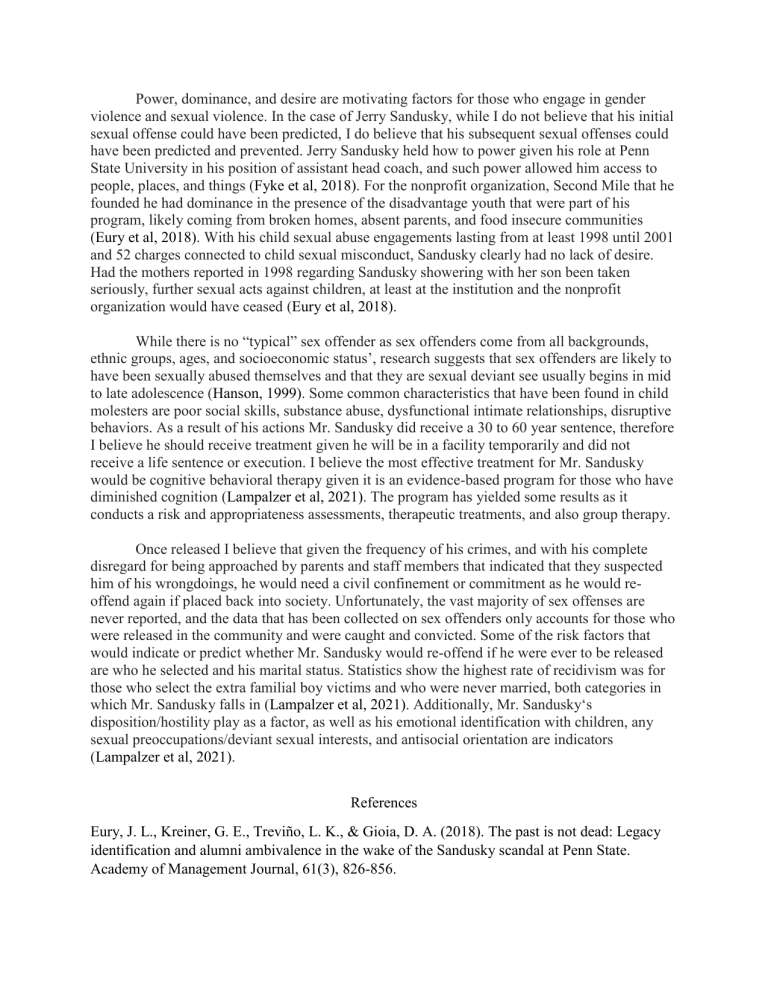Gender Violence, Sexual Offenses & Recidivism: Sandusky Case
advertisement

Power, dominance, and desire are motivating factors for those who engage in gender violence and sexual violence. In the case of Jerry Sandusky, while I do not believe that his initial sexual offense could have been predicted, I do believe that his subsequent sexual offenses could have been predicted and prevented. Jerry Sandusky held how to power given his role at Penn State University in his position of assistant head coach, and such power allowed him access to people, places, and things (Fyke et al, 2018). For the nonprofit organization, Second Mile that he founded he had dominance in the presence of the disadvantage youth that were part of his program, likely coming from broken homes, absent parents, and food insecure communities (Eury et al, 2018). With his child sexual abuse engagements lasting from at least 1998 until 2001 and 52 charges connected to child sexual misconduct, Sandusky clearly had no lack of desire. Had the mothers reported in 1998 regarding Sandusky showering with her son been taken seriously, further sexual acts against children, at least at the institution and the nonprofit organization would have ceased (Eury et al, 2018). While there is no “typical” sex offender as sex offenders come from all backgrounds, ethnic groups, ages, and socioeconomic status’, research suggests that sex offenders are likely to have been sexually abused themselves and that they are sexual deviant see usually begins in mid to late adolescence (Hanson, 1999). Some common characteristics that have been found in child molesters are poor social skills, substance abuse, dysfunctional intimate relationships, disruptive behaviors. As a result of his actions Mr. Sandusky did receive a 30 to 60 year sentence, therefore I believe he should receive treatment given he will be in a facility temporarily and did not receive a life sentence or execution. I believe the most effective treatment for Mr. Sandusky would be cognitive behavioral therapy given it is an evidence-based program for those who have diminished cognition (Lampalzer et al, 2021). The program has yielded some results as it conducts a risk and appropriateness assessments, therapeutic treatments, and also group therapy. Once released I believe that given the frequency of his crimes, and with his complete disregard for being approached by parents and staff members that indicated that they suspected him of his wrongdoings, he would need a civil confinement or commitment as he would reoffend again if placed back into society. Unfortunately, the vast majority of sex offenses are never reported, and the data that has been collected on sex offenders only accounts for those who were released in the community and were caught and convicted. Some of the risk factors that would indicate or predict whether Mr. Sandusky would re-offend if he were ever to be released are who he selected and his marital status. Statistics show the highest rate of recidivism was for those who select the extra familial boy victims and who were never married, both categories in which Mr. Sandusky falls in (Lampalzer et al, 2021). Additionally, Mr. Sandusky‘s disposition/hostility play as a factor, as well as his emotional identification with children, any sexual preoccupations/deviant sexual interests, and antisocial orientation are indicators (Lampalzer et al, 2021). References Eury, J. L., Kreiner, G. E., Treviño, L. K., & Gioia, D. A. (2018). The past is not dead: Legacy identification and alumni ambivalence in the wake of the Sandusky scandal at Penn State. Academy of Management Journal, 61(3), 826-856. Fyke, J., Trisler, B., & Lucas, K. (2018). A failure of courageous leadership: sex, embarrassment, and (not) speaking up in the Penn State sexual abuse scandal. In Leadership and Sexuality (pp. 73-90). Edward Elgar Publishing. Hanson, R. K., Scott, H., & Steffy, R. A. (1995). A Comparison of Child Molesters and NonSexual Criminals: Risk Predictors and Long-term Recidivism. Journal of Research in Crime and Delinquency, 32(3), 325-337. Lampalzer, U., Tozdan, S., von Franqué, F., & Briken, P. (2021). Referral for group or individual treatment? Factors for consideration in the case of self-referred individuals with a sexual interest in minors. International Journal of Impotence Research, 33(3), 348-363.




